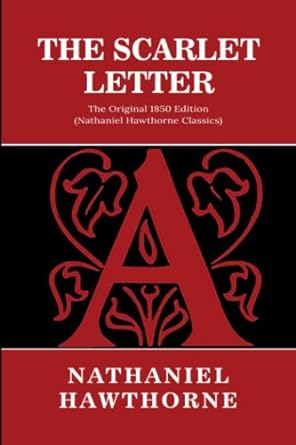Welcome back, avid readers! This week, we journey into the heart of Puritan New England with Nathaniel Hawthorne’s classic, “The Scarlet Letter.” Get ready to explore themes of sin, redemption, and societal judgment in this enduring tale of moral complexity and human resilience.
Introduction
“The Scarlet Letter,” published in 1850, is a profound exploration of the human condition, delving into themes of sin, guilt, and redemption. Set in 17th-century Puritan Massachusetts, Hawthorne’s novel centers on the life of Hester Prynne, a woman condemned to wear a scarlet “A” for adultery. Through richly drawn characters and symbolic narrative, Hawthorne critiques the rigidity and hypocrisy of a society that punishes individual transgressions while concealing its own moral failings. Join us as we delve into the layers of this remarkable work.
Quick Summary
“The Scarlet Letter” opens with Hester Prynne standing before a stern Puritan crowd, clutching her infant daughter, Pearl. Hester has been condemned to wear a scarlet letter “A” on her chest as a mark of her sin. Her refusal to name the father of her child and her dignified acceptance of her punishment isolate her from the community. As the story unfolds, we learn about the tormented Reverend Arthur Dimmesdale, who is Pearl’s father, and Roger Chillingworth, Hester’s vengeful husband disguised as a physician. The novel explores the inner struggles of these characters as they grapple with guilt, revenge, and the quest for forgiveness.
Character List and Descriptions
Hester Prynne: The novel’s protagonist, Hester is a strong, dignified woman who endures public shaming and ostracism with grace. Her resilience and compassion shine through as she raises her daughter, Pearl, and aids the needy in her community.
Pearl: Hester’s spirited and perceptive daughter, Pearl is often described as an elf-like child with a mischievous nature. She symbolizes both Hester’s sin and her vitality, challenging the moral rigidity of the Puritan society.
Arthur Dimmesdale: The young, eloquent minister who is secretly Pearl’s father. Dimmesdale’s intense guilt and fear of exposure lead to severe physical and mental anguish, as he struggles with his conscience and his duty to his congregation.
Roger Chillingworth: Hester’s estranged husband who arrives in the colony under the guise of a physician. Consumed by a desire for revenge, Chillingworth devotes himself to uncovering and tormenting Hester’s unnamed lover.
Governor Bellingham: A wealthy, influential leader in the Puritan community, Bellingham represents the strict, legalistic side of the society that condemns Hester.
Mistress Hibbins: Governor Bellingham’s sister, known for her eccentricity and rumored involvement in witchcraft. Her character provides a stark contrast to the outward piety of the community.
Themes
Sin and Redemption: Central to the novel is the theme of sin and the possibility of redemption. Hester’s journey from shame to acceptance and Dimmesdale’s struggle for forgiveness highlight the complexities of human morality.
Individual vs. Society: The novel explores the tension between individual identity and societal expectations. Hester’s defiance of the community’s moral code and her eventual empowerment underscore the conflict between personal integrity and communal judgment.
Guilt and Punishment: Hawthorne delves into the psychological effects of guilt and the various ways it manifests. While Hester bears her punishment openly, Dimmesdale’s hidden guilt eats away at him, illustrating the destructive power of internalized shame.
Hypocrisy and Integrity: The novel critiques the hypocrisy of a society that outwardly condemns sin while concealing its own moral failings. Characters like Dimmesdale and Chillingworth exemplify the dangers of living a duplicitous life.
Isolation and Alienation: Hester’s punishment leads to her physical and social isolation, but it also fosters a sense of independence and strength. The novel examines how isolation can both damage and fortify the human spirit.
Conclusion
In conclusion, “The Scarlet Letter” remains a powerful exploration of sin, redemption, and the human condition. Hawthorne’s rich symbolism and complex characters continue to resonate with readers, inviting us to reflect on the moral and societal issues that shape our lives. Join us for more literary adventures and insightful discussions right here at Curvebreakers!
Looking for additional resources? Check out our comprehensive AP English Language and Writing study guide for more assistance on your literary journey. Happy reading!

